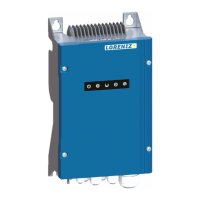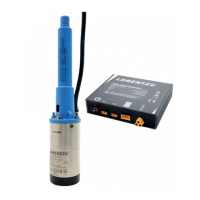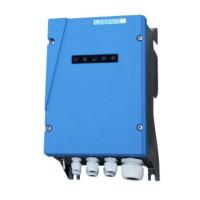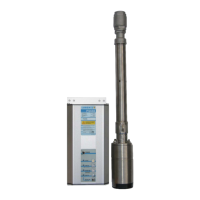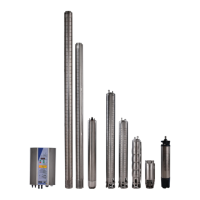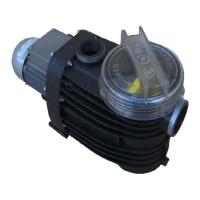CAUTIONS
for polyethylene pipe
(PE, rolled pipe)
Do not exceed the pressure rating of the pipe. 1.
The most common PE pipe is type SIDR-15. It
has a pressure rating of 100 PSI (7 bar). This
is equal to 230 ft (70 m) of total vertical lift.
Types SDR-9 and SIDR-7 have a pressure rat-
ing of 200 PSI (14 bar), equal to 460 ft (140 m).
They is available from local suppliers in some
areas, or from your Solar pump supplier.
Special compression connectors are made for
this pipe.
Use only pipe connectors that are designed 2.
for the pipe you choose. Do not use galva-
nized steel adapters. They will rust through.
Do not use any sealing compound in PE pipe 3.
connections.
If you use insert connectors with hose clamps, 4.
use TWO clamps at each adapter. Tighten
them with a wrench. Use “all stainless” hose
clamps. Automotive clamps have carbon steel
screws that will rust and fail.
Have extra hose clamps on hand in case you 5.
damage or lose one.
Have an extra coupling on hand in case you 6.
bend the pipe too sharply (kink it) and make
a weak spot.
PE pipe will stretch about 1 %. Make the 7.
electrical cable and safety rope about 1.5 %
longer than the pipe so when the pipe
stretches, the cable and splice will not be
stressed.
If you plan to bury PE pipe in the ground, 8.
contact the pipe manufacturer for additional
instructions.
Sanitizing a well will kill bacteria that may have been
introduced during the pump installation. This can be done
with chlorine bleach or chlorine pellets poured down the
well just before or just after a pump is installed. Once
you introduce these chemicals make sure that the pump
is working to prevent that it sits for a longer time in the
aggressive environment.
Consult a local supplier or environmental health authority
for a recommended procedure. Do not use an excessive
concentration.
WARNING PS pumps may be
damaged by soaking in a high
concentration of chlorine solution.
Avoid prolonged contact.
Sanitizing the Well6.4
SEE REFERENCE SECTION At the end of this manual
(section 13) you will find instructions for wellhead assem-
bly, water storage, control and monitoring of water supply,
pipe sizing, freeze protection, and more.
Water well pumps can be installed by hand in shallow
water sources and in remote areas that are not accessible
to a pump service truck. Hand installation is generally
performed using rolled flexible POLYETHYLENE (PE) drop
pipe rather than rigid pipe. In North America, most profes-
sional pump contractors do NOT have the equipment to
pull flexible pipe. Their equipment is designed for rigid pipe
in 21 ft (7 m) pieces. Do not use flexible pipe unless you are
committed to safely handling its total weight (full of water)
IN THE FUTURE when the pump must be removed. For
installations that are deeper than about 50 ft (15 m), please
consider the following warnings and cautions.
WARNING Hand installation and
removal is potentially hazardous. We
do not encourage hand installation
except in shallow-water situations.
Installation and removal should never be
performed by hand without an adequate number of
workers. If you have any doubts about the
feasibility, safety and economy of installation AND
future removal, hire a professional pump service
contractor.
Before considering installation or removal by hand,
estimate the weight of the system and consider the number
of people necessary to install the pump AND to remove it
in the future (with water in the pipe). To estimate the total
weight, add the following:
Cable weight — #10 submersible cable (3-wire 1.
+ ground) weighs approximately 25 lbs per 100 ft
(40 kg per 100 m). Each larger size (smaller AWG#)
weighs approximately 30 % more.
Water in the pipe (lbs) = pipe inside diameter 2.
(inches)
2
× 0.34 × length (ft). Example: Water in
100 ft of 1 in pipe weighs about 34 lbs.
The pump weighs approximately 25 lbs (11.5 kg).3.
WARNING DO NOT USE A VEHICLE to
install or remove a pump. During
removal, the pump can catch on
joints or edges in the well casing.
Damage or loss of the pump can occur before the
vehicle operator can react.
WARNING DO NOT USE A ROPE
WINCH to install or remove a pump
in a drilled well casing (borehole). If
you use a winch to pull the pump by
pulling the safety rope, the electrical cable can slip
down the pipe and/or the pipe can collapse. If the
pipe or cable jams and gets wedged in the casing,
you can lose your equipment and even permanent-
ly block the well! Some installers use a winch with
a reel of about 3 ft (1 m) diameter or larger, to pull
flexible pipe.
Hand Installation6.3
